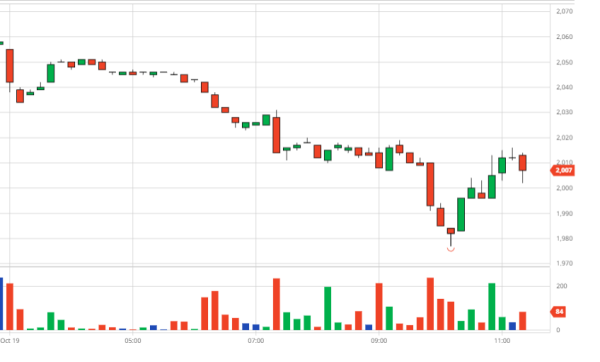Coffee prices continued to fall deeply, with increasing pressure on monetary interest rates causing investors to adjust their portfolios, while the first announcement day (FND) is also approaching…

Robusta chart London T11/2022 session on October 19, 2022
At the end of the session, the price of Robusta coffee on ICE Europe – London continued to decline. The November spot term decreased by 45 USD, down to 2,012 USD/ton and the term for delivery in January 2023 decreased by 34 USD to 2,000 USD/ton, sharp declines. Trading volume is very above average. Robusta coffee prices fell to a nearly 3-month low.
Similarly, the price of Arabica coffee on the ICE US floor – New York extended the chain of decline to the sixth session. December spot futures fell another 2.80 cents to 192.30 cents/lb and March 2023 futures fell another 3.05 cents to 187.25 cents/lb, very significant reductions. Trading volume remained quite above average. Arbica coffee price fell to a 13-month low.
The price of green coffee beans in the Central Highlands provinces decreased by 800-900 dong, down to the range of 43,700-44,200 dong/kg.
The price of coffee on the two floors continued to extend the decline chain when USDX continued the uptrend in the world currency market after the central banks of Asian countries released USD reserves to prevent the weakening of their currencies. U.S. stocks tumbled, in a portfolio correction session, as pressure on interest rates increased through Fed officials’ tougher tone on high inflation and continued monetary tightening. .
Information that the main coffee growing areas in the south of Brazil have abundant rain, helping coffee trees to grow new crops very well, promising that next year’s crop will develop smoothly. The Coffee Exporters Association (Cecafé) reported exports for September totaling 3.386 million bags, up 4.5% year-on-year, including both instant and roasted coffee. The inventory report on the two exchanges continued to decline, but inventories in major consuming markets were still abundant, while demand slowed down due to limited consumer income due to high inflation.
The phenomenon of structural inversion, often called price squeeze, on both futures exchanges only benefits spot traders, while the first delivery notice date (FND) is also near.
English (giacaphe.com)
